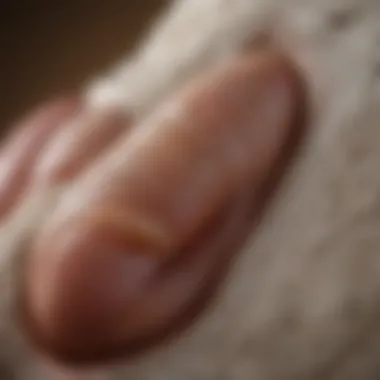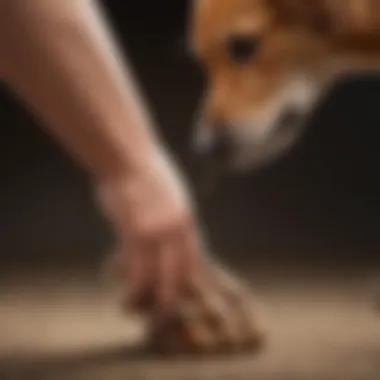Unraveling the Enigma of Dogs Constantly Licking Their Paws


Pet Care Essentials
Behavior & Training
In the realm of behavior and training, comprehending why dogs constantly lick their paws provides insight into their emotional state and overall communication. Understanding your pet's body language is key to identifying distress signals that may manifest in excessive paw licking. Implementing basic training techniques can help redirect this behavior towards more positive outlets, enhancing your bond with your furry companion. Addressing behavioral concerns and finding suitable solutions is paramount in promoting a harmonious relationship with your pet. Socialization tips further contribute to your dog's overall well-being, reducing anxiety that may trigger compulsive behaviors.
Pet Home Environment
Creating a pet-friendly space is essential for addressing why dogs constantly lick their paws. Ensuring a safe environment free from potential hazards is crucial in preventing stress-induced habits. Selecting the right toys and accessories can offer mental stimulation, reducing the likelihood of excessive licking due to boredom. Setting up a comfortable resting area provides your dog with a sense of security and relaxation, minimizing anxiety triggers that may result in paw licking tendencies.
Pet Health Issues
In the context of pet health issues, recognizing signs of illness is imperative when investigating why dogs constantly lick their paws. Regular health and wellness check-ins can aid in early detection of underlying medical conditions that may contribute to this behavior. Implementing preventative care measures, such as flea and tick prevention, can mitigate skin irritations that could lead to excessive paw licking. Familiarizing yourself with common ailments and their respective treatments equips you to address any health concerns promptly. Additionally, being prepared for emergencies ensures quick intervention in case excessive paw licking is indicative of a critical health issue.
Foreword
Understanding Normal Paw Licking Behavior
In the realm of canine behavior, the intricate act of paw licking stands out as a behavior that captivates the interest of many dog owners. Delving into the core of this behavior provides a lens through which one can gain valuable insights into a dog's overall well-being. Understanding normal paw licking behavior goes beyond a surface-level observation; it unravels a tapestry of elements that showcase a dog's grooming habits, emotional state, and potential health concerns. By peeling back the layers of this behavior, one can decipher the subtleties that hint at various underlying issues affecting a furry companion.
Maintaining Hygiene
Within the realm of paw licking, the aspect of maintaining hygiene emerges as a pivotal point of consideration. Dogs inherently possess a strong inclination towards grooming themselves, with paw licking being a fundamental part of this ritual. This behavior enables dogs to cleanse their paws from accumulated dirt, grime, and other external pollutants that they encounter in their day-to-day activities. By meticulously licking their paws, dogs exhibit a natural instinct for cleanliness that aids in preventing potential infections or irritations that could arise if hygiene levels are compromised.


Soothing Discomfort
Amidst the mosaic of reasons behind paw licking, the facet of soothing discomfort plays a vital role in understanding this behavior. Dogs, much like humans, resort to self-soothing mechanisms when faced with discomfort, whether physical or emotional in nature. Paw licking serves as a coping mechanism for dogs dealing with various discomforts, such as minor injuries, skin irritations, or emotional stress. Observing a dog engaging in excessive paw licking could signify an underlying issue that warrants attention and investigation to alleviate any distress they may be experiencing.
Exploratory Behavior
Apart from hygiene and comfort, the intriguing dimension of exploratory behavior threads through the act of paw licking. Dogs are inherently curious creatures, relying heavily on their senses to navigate and comprehend the world around them. Through licking their paws, dogs engage in a sensory exploration that allows them to gather information about their environment, other animals, and even themselves. This behavior acts as a form of communication and self-discovery, showcasing the intricate ways in which dogs interact with their surroundings and express their innate curiosity.
Possible Medical Causes
Understanding the potential medical causes behind why dogs constantly lick their paws is crucial in deciphering their behavior. Medical issues can significantly impact a dog's well-being and understanding these factors is essential for pet owners. By recognizing the signs and symptoms of possible medical causes, such as allergies, infections, and pain/discomfort, pet owners can proactively address their furry companions' health concerns.
Allergies
Allergies are a common medical reason for dogs to incessantly lick their paws. Whether triggered by food, pollen, or other allergens, dogs may exhibit paw licking as a way to alleviate itching and discomfort. Understanding the specific allergens affecting your dog can help in devising a suitable treatment plan. Consultation with a veterinarian is essential for identifying and managing allergies effectively to reduce paw licking behaviors.
Infections
Infections, whether bacterial or fungal, can lead to paw licking in dogs. The moist environment between the paws provides a breeding ground for infections, causing irritation and prompting excessive licking. Recognizing the signs of infections, such as redness, swelling, or discharge, is vital for timely intervention. Proper diagnosis and treatment by a vet are crucial to resolve infections and alleviate the need for continual paw licking.
Pain and Discomfort
Dogs might lick their paws due to pain or discomfort caused by various underlying issues, including injuries, arthritis, or nerve damage. Persistent licking in a concentrated area could indicate localized pain that requires attention. Identifying the source of pain through a thorough examination by a veterinarian is necessary to address the root cause and provide pain relief for the dog. Managing pain effectively can help reduce paw licking tendencies and improve the overall well-being of the furry companion.


Environmental Triggers
In the realm of comprehending the intricate motives behind dogs perpetually engaging in paw licking, the examination of environmental triggers emerges crucial. Addressing this facet within the narrative constructs a foundation for understanding how external factors lead to such behavior. Environmental triggers, encompassing a spectrum of influences from the surroundings, play a pivotal role in shaping a dog's actions.
Stress and Anxiety
Delving into the realm of stress and anxiety, one uncovers profound elements that significantly impact a dog's penchant for incessant paw licking. The weight of these emotional states resonates deeply within a canine's behavior, often manifesting through repetitive actions such as paw licking. Understanding the correlation between stress, anxiety, and paw licking unveils layers of complexity in a dog's emotional well-being.
Boredom and Lack of Stimulation
Exploring the dimensions of boredom and lack of stimulation sheds light on how these factors contribute to a dog's tendency to excessively lick their paws. When left devoid of mental and physical engagement, dogs may resort to mechanisms like paw licking as a form of self-soothing or activity. Recognizing the significance of providing adequate mental and physical stimuli can mitigate behaviors stemming from monotony.
Seasonal Factors
Seasonal factors introduce an intriguing angle to the discourse on dogs' paw licking habits, captivating the influence of changing climates on this behavior. Dogs, akin to humans, may exhibit altered behaviors in response to seasonal variations, potentially escalating paw licking tendencies during specific times of the year. Understanding how seasonal shifts impact a dog's behavior can aid in contextualizing and addressing changes in paw licking patterns.
Behavioral Reasons
Behavioural reasons behind why dogs constantly lick their paws are a crucial aspect of understanding their well-being. This section delves deep into the various psychological and habitual factors that contribute to this behaviour. By exploring the behavioural root causes, pet owners can gain valuable insight into their furry companions' mental and emotional states, leading to more effective intervention strategies. Understanding these reasons can help pet owners address the issue at its core, promoting overall pet health and happiness.
Compulsive Behavior
Compulsive behavior in dogs, such as excessive paw licking, is often a result of underlying anxiety or stress. Dogs may exhibit repetitive behaviors like incessant paw licking as a coping mechanism for emotional distress. It is essential for pet owners to identify triggers that lead to compulsive behavior and work on alleviating the root cause to help their pets lead healthier and more balanced lives.


Attention-Seeking
Dogs are social animals that thrive on human interaction and attention. Attention-seeking behavior, including excessive paw licking, can be a way for dogs to seek comfort, reassurance, or engagement from their owners. Understanding the underlying motivations behind attention-seeking behaviour can help pet owners provide adequate emotional support and companionship to satisfy their furry friends' social needs.
Habit Formation
Habit formation plays a significant role in dogs' behavior, including paw licking. Dogs can develop habits like excessive paw licking due to environmental triggers, boredom, or learned behaviours. Breaking these habits requires patience, consistency, and positive reinforcement. By understanding how habits are formed and maintained, pet owners can implement successful strategies to modify their dogs' behaviour and promote healthier alternatives.
Tips for Addressing Excessive Paw Licking
Addressing excessive paw licking in dogs is a crucial aspect of pet care, ensuring their well-being and happiness. In this section, we delve deep into effective strategies to help your furry companion overcome this behavior. By understanding the root causes behind excessive paw licking, pet owners can implement appropriate measures to provide relief and support to their canine friends. Whether the issue stems from medical conditions or behavioral triggers, addressing it promptly is key to fostering a healthy and content pet.
Consulting a Veterinarian
When dealing with excessive paw licking in dogs, consulting a veterinarian is paramount. A professional evaluation can help rule out underlying health issues that may be causing this behavior. Veterinarians can conduct thorough examinations to identify any potential allergies, infections, or pain-related issues that could be triggering the excessive licking. Their expertise allows for proper diagnosis and treatment plans tailored to your pet's specific needs.
Maintaining Proper Grooming
Proper grooming plays a significant role in managing excessive paw licking in dogs. Regular grooming routines help keep your pet's paws clean and healthy, reducing the likelihood of irritation or discomfort that may lead to excessive licking. Trimming your dog's nails appropriately, keeping the fur around the paws well-maintained, and ensuring overall cleanliness can discourage compulsive licking behaviors. Additionally, grooming sessions provide an opportunity to inspect your dog's paws for any signs of injury or abnormalities that require attention.
Creating Distractions
Creating distractions is an effective strategy to redirect your dog's focus away from excessive paw licking. Engaging your pet in mentally stimulating activities, such as interactive toys or puzzle feeders, can help channel their energy and prevent them from fixating on their paws. Regular exercise and playtime not only keep your dog physically active but also mentally engaged, reducing boredom and anxiety that may contribute to the licking behavior. By introducing new toys, rotating play options, and incorporating positive reinforcement techniques, pet owners can successfully divert their dog's attention towards healthier habits.
Epilogue
The topic of why dogs constantly lick their paws is not merely a surface-level concern but a gateway to understanding our beloved canine companions on a deeper level. This article has meticulously dissected the various reasons behind this behavior, bridging the gap between pet owners and the nuances of their furry friends' well-being. By delving into the intricacies of paw licking, we unravel a tapestry of potential medical issues, behavioral triggers, and environmental factors that may influence our dogs' repetitive licking habits.
Diving deeper into this behavior, we uncover a realm where maintaining hygiene, soothing discomfort, and indulging in exploratory behavior intertwine to form a complex narrative behind paw licking. From allergies to infections and pain, dogs' licking can signal underlying health issues that necessitate attention. Environmental triggers like stress, anxiety, boredom, and seasonal variations play pivotal roles in unraveling the mystery behind excessive paw licking, offering insight into our dogs' mental and emotional well-being.
Furthermore, our exploration extends to behavioral reasons that may drive this habit, including compulsive behavior, attention-seeking tendencies, and habit formation. Understanding these behavioral cues sheds light on our dogs' psyche and helps decipher their communication modes beyond barks and tail wags. Equipped with this knowledge, pet owners can proactively address excessive paw licking, ensuring their furry companions lead healthier, happier lives.







